#american horror story 1894
Text
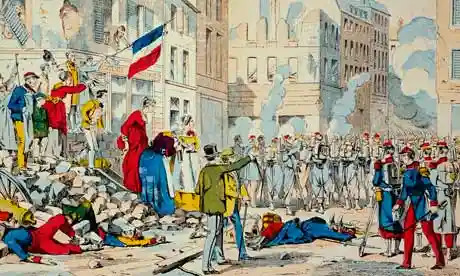
Some Comments from Mitch Abidor on Gaston Leroux’s Phantom of the Opera
Mitch Abidor is an American writer, translator, and specialist in French radical history. He is a translator for marxists.org and has written numerous books on French history and labor movements, including the 1871 Paris Commune and the Mai 68 protests. There was no one I would rather talk to about the Phantom of the Opera.
I first came across Mr. Abidor’s name while looking up the transcripts of the 1894 trials of anarchist-terrorists that Gaston Leroux reported on early in his journalism career. Abidor translated those transcripts from French into English for marxists.org, an online archive of Marxist documents and histories. I wrote about the three anarchists and the impact they may have had on Leroux’s novel in this post.
In May of last year, I reached out to Abidor via email about his thoughts on the role of the Paris Commune and the echoes of Anarchic-terrorism found in the Phantom of the Opera. He was gracious enough to send a short response and gave me permission to share his words here.
Abidor confessed it has been several decades since he last read the Phantom of the Opera, but he was of course familiar with Leroux and the mentions he made of the Paris Commune in his novel. In the novel, Leroux’s narrator, G.L., makes several claims about the Commune and the Opera house that do not line up with actual history. Mainly, that the Commune ever built a prison or dungeon or held prisoners under the Opera:
There was no Commune prison under the opera house: the hostages they held and those they arrested were held in Paris' established prisons. He also talks about people executed in the cellars of the Opera, which is absolutely false, a pure invention, as is his claim that hot air balloons took off from there.
Why would Leroux make up these details? Of course, the novel is fiction, but what purpose do these Commune details serve?
Leroux, who was from a wealthy family, doubtless grew up on stories of the alleged horrors of the Commune, so he probably figured why not add a prison to the water flowing beneath the building. It makes it all that much uglier.
Leroux covered the 1894 trials and executions of three anarchists who had committed acts of terrorism: Auguste Vaillant, Émile Henry, and Sante Geronimo Caserio. What impact might that experience have had on Leroux’s novel?
The anarchists were all-purpose villains for people like Leroux, so that his bad guy should echo people like Vaillant - who was kind of pitiful in reality, and Henry, who really was an unabashed hater of the bourgeoisie, is also not a surprise.
Many thanks to Mitch Abidor for providing his expertise on the subject! For me, the Phantom of the Opera has been a gateway into studying the Paris Commune and the anarchists of the late twentieth century. Erik is a fascinating character to me because he has been made up of so many parts of reality, but scrambled into pure fiction.
#poto paris commune 1871#paris commune#phantom of the opera#gaston leroux#le fantôme de l'opéra#french history#frev#mitch abidor
57 notes
·
View notes
Text
For our next profile for Writers in Horror Month 2023 we have Edogawa Ranpo…
Born Tarō Hirai
October 21, 1894
Mie, Empire of Japan
Died July 28, 1965 (aged 70)
Occupation Novelist, literary critic
Language Japanese
Nationality Japanese
Alma mater Waseda University
Genre Mystery, weird fiction, thriller
Tarō Hirai (平井 太郎, Hirai Tarō, October 21, 1894 – July 28, 1965), better known by the pen name Edogawa Ranpo (江戸川 乱歩)[a] was a Japanese author and critic who played a major role in the development of Japanese mystery and thriller fiction. Many of his novels involve the detective hero Kogoro Akechi, who in later books was the leader of a group of boy detectives known as the "Boy Detectives Club" (少年探偵団, Shōnen tantei dan).
Ranpo was an admirer of Western mystery writers, and especially of Edgar Allan Poe. His pen name is a rendering of Poe's name. Other authors who were special influences on him were Sir Arthur Conan Doyle, whom he attempted to translate into Japanese during his days as a student at Waseda University, and the Japanese mystery writer Ruikō Kuroiwa.
Biography
Before World War II
Tarō Hirai was born in Nabari, Mie Prefecture in 1894, where his grandfather had been a samurai in the service of Tsu Domain. His father was a merchant, who had also practiced law. The family moved to what is now Kameyama, Mie, and from there to Nagoya when he was age two. At the age of 17, he studied economics at Waseda University in Tokyo starting in 1912. After graduating in 1916 with a degree in economics, he worked a series of odd jobs, including newspaper editing, drawing cartoons for magazine publications, selling soba noodles as a street vendor, and working in a used bookstore.
In 1923, he made his literary debut by publishing the mystery story "The Two-Sen Copper Coin" (二銭銅貨, Ni-sen dōka) under the pen name "Edogawa Ranpo" (pronounced quickly, this humorous pseudonym sounds much like the name of the American pioneer of detective fiction, Edgar Allan Poe, whom he admired). The story appeared in the magazine Shin Seinen, a popular magazine written largely for an adolescent audience. Shin Seinen had previously published stories by a variety of Western authors including Poe, Arthur Conan Doyle, and G. K. Chesterton, but this was the first time the magazine published a major piece of mystery fiction by a Japanese author. Some, such as James B. Harris (Ranpo's first translator into English), have erroneously called this the first piece of modern mystery fiction by a Japanese writer,[3] but well before Ranpo entered the literary scene in 1923, a number of other modern Japanese authors such as Ruikō Kuroiwa, Kidō Okamoto, Jun'ichirō Tanizaki, Haruo Satō, and Kaita Murayama had incorporated elements of sleuthing, mystery, and crime within stories involving adventure, intrigue, the bizarre, and the grotesque.[4] What struck critics as new about Ranpo's debut story "The Two-Sen Copper Coin" was that it focused on the logical process of ratiocination used to solve a mystery within a story that is closely related to Japanese culture.[5] The story involves an extensive description of an ingenious code based on a Buddhist chant known as the "nenbutsu" as well as Japanese-language Braille.
Over the course of the next several years, Edogawa went on to write a number of other stories that focus on crimes and the processes involved in solving them. Among these stories are a number of stories that are now considered classics of early 20th-century Japanese popular literature: "The Case of the Murder on D. Hill" (D坂の殺人事件, D-zaka no satsujin jiken, January 1925), which is about a woman who is killed in the course of a sadomasochistic extramarital affair, "The Stalker in the Attic" (屋根裏の散歩者, Yane-ura no Sanposha, August 1925), which is about a man who kills a neighbor in a Tokyo boarding house by dropping poison through a hole in the attic floor into his mouth, and "The Human Chair" (人間椅子, Ningen Isu, October 1925), which is about a man who hides himself in a chair to feel the bodies on top of him Mirrors, lenses, and other optical devices appear in many of Edogawa's other early stories, such as "The Hell of Mirrors".
Although many of his first stories were primarily about sleuthing and the processes used in solving seemingly insolvable crimes, during the 1930s, he began to turn increasingly to stories that involved a combination of sensibilities often called "ero guro nansensu", from the three words "eroticism, grotesquerie, and the nonsensical" The presence of these sensibilities helped him sell his stories to the public, which was increasingly eager to read his work. One finds in these stories a frequent tendency to incorporate elements of what the Japanese at that time called "abnormal sexuality" (変態性欲, hentai seiyoku). For instance, a major portion of the plot of the novel The Demon of the Lonely Isle (孤島の鬼, Kotō no oni), serialized from January 1929 to February 1930 in the journal Morning Sun (朝日, Asahi), involves a homosexual doctor and his infatuation for another main character.
By the 1930s, Edogawa was writing regularly for a number of major public journals of popular literature, and he had emerged as the foremost voice of Japanese mystery fiction. The detective hero Kogorō Akechi, who had first appeared in the story "The Case of the Murder on D. Hill" became a regular feature in his stories, a number of which pitted him against a dastardly criminal known as the Fiend with Twenty Faces (怪人二十面相, Kaijin ni-jū mensō), who had an incredible ability to disguise himself and move throughout society. (A number of these novels were subsequently made into films.) The 1930 novel introduced the adolescent Kobayashi Yoshio (小林芳雄) as Kogoro's sidekick, and in the period after World War II, Edogawa wrote a number of novels for young readers that involved Kogoro and Kobayashi as the leaders of a group of young sleuths called the "Boy Detectives Club" (少年探偵団, Shōnen tantei dan). These works were wildly popular and are still read by many young Japanese readers, much like the Hardy Boys or Nancy Drew mysteries are popular mysteries for adolescents in the English-speaking world.
During World War II
In 1939, two years after the Marco Polo Bridge Incident and the outbreak of the Second Sino-Japanese War in 1937, Edogawa was ordered by government censors to drop his story "The Caterpillar" (芋虫, Imo Mushi), which he had published without incident a few years before, from a collection of his short stories that the publisher Shun'yōdō was reprinting. "The Caterpillar" is about a veteran who was turned into a quadriplegic and so disfigured by war that he was little more than a human "caterpillar", unable to talk, move, or live by himself. Censors banned the story, apparently believing that the story would detract from the current war effort. This came as a blow to Ranpo, who relied on royalties from reprints for income. (The short story inspired director Kōji Wakamatsu, who drew from it his movie Caterpillar, which competed for the Golden Bear at the 60th Berlin International Film Festival.)
Over the course of World War II, especially during the full-fledged war between Japan and the US that began in 1941, Edogawa was active in his local neighborhood organization, and he wrote a number of stories about young detectives and sleuths that might be seen as in line with the war effort, but he wrote most of these under different pseudonyms as if to disassociate them with his legacy. In February 1945, his family was evacuated from their home in Ikebukuro, Tokyo to Fukushima in northern Japan. Edogawa remained until June, when he was suffering from malnutrition. Much of Ikebukuro was destroyed in Allied air raids and the subsequent fires that broke out in the city, but the thick, earthen-walled warehouse which he used as his studio was spared, and still stands to this day beside the campus of Rikkyo University.
Postwar
In the postwar period, Edogawa dedicated a great deal of energy to promoting mystery fiction, both in terms of the understanding of its history and encouraging the production of new mystery fiction. In 1946, he put his support behind a new journal called Jewels (宝石, Hōseki) dedicated to mystery fiction, and in 1947, he founded the Detective Author's Club (探偵作家クラブ, Tantei sakka kurabu), which changed its name in 1963 to the Mystery Writers of Japan (日本推理作家協会, Nihon Suiri Sakka Kyōkai). In addition, he wrote a large number of articles about the history of Japanese, European, and American mystery fiction. Many of these essays were published in book form. Other than essays, much of his postwar literary production consisted largely of novels for juvenile readers featuring Kogorō Akechi and the Boy Detectives Club.
In the 1950s, he and a bilingual translator collaborated for five years on a translation of Edogawa's works into English, published as Japanese Tales of Mystery and Imagination by Tuttle. Since the translator could speak but not read Japanese, and Edogawa could read but not write English, the translation was done aurally, with Edogawa reading each sentence aloud, then checking the written English.[3]
Another of his interests, especially during the late 1940s and 1950s, was bringing attention to the work of his dear friend Jun'ichi Iwata (1900–1945), an anthropologist who had spent many years researching the history of homosexuality in Japan. During the 1930s, Edogawa and Iwata had engaged in a light-hearted competition to see who could find the most books about erotic desire between men. Edogawa dedicated himself to finding books published in the West and Iwata dedicated himself to finding books having to do with Japan. Iwata died in 1945, with only part of his work published, so Edogawa worked to have the remaining work on queer historiography published
In the postwar period, a large number of Edogawa's books were made into films. The interest in using Edogawa's literature as a departure point for creating films has continued well after his death. Edogawa, who had a variety of health issues, including atherosclerosis and Parkinson's disease, died from a cerebral hemorrhage at his home in 1965. His grave is at the Tama Cemetery in Fuchu, near Tokyo.
The Edogawa Rampo Prize (江戸川乱歩賞 Edogawa Ranpo Shō?), named after Edogawa Rampo, is a Japanese literary award which has been presented every year by the Mystery Writers of Japan since 1955. The winner is given a prize of ¥10 million with publication rights by Kodansha.
Works in English translation
Books
• Edogawa Rampo (1956), Japanese Tales of Mystery and Imagination, translated by James B. Harris. 14th ed. Rutland, VT: Charles E. Tuttle Company. ISBN 978-0-8048-0319-9.
• Edogawa Ranpo (1988), The Boy Detectives Club, translated by Gavin Frew. Tokyo: Kodansha. ISBN 978-4-0618-6037-7.
• Edogawa Rampo (2006), The Black Lizard and Beast in the Shadows, translated by Ian Hughes. Fukuoka: Kurodahan Press. ISBN 978-4-902075-21-2.
• Edogawa Rampo (2008), The Edogawa Rampo Reader, translated by Seth Jacobowitz. Fukuoka: Kurodahan Press. ISBN 978-4-902075-25-0. Contains many of Rampo's early short stories and essays.
• Edogawa Rampo (2009), Moju: The Blind Beast, translated by Anthony Whyte. Shinbaku Books. ISBN 978-1840683004.
• Edogawa Rampo (2012), The Fiend with Twenty Faces, translated by Dan Luffey. Fukuoka: Kurodahan Press. ISBN 978-4-902075-36-6.
• Edogawa Ranpo (2013), Strange Tale of Panorama Island, translated by Elaine Kazu Gerbert. Honolulu: University of Hawaiʻi Press. ISBN 978-0824837037.
• Edogawa Rampo (2014), The Early Cases of Akechi Kogoro, translated by William Varteresian. Fukuoka: Kurodahan Press. ISBN 978-4-902075-62-5.
• Edogawa Rampo (2019), Gold Mask, translated by William Varteresian. Fukuoka: Kurodahan Press. ISBN 978-4909473066.
Short stories
• Edogawa Ranpo (2008), "The Two-Sen Copper Coin," translated by Jeffrey Angles, Modanizumu: Modernist Fiction from Japan, 1913–1938, ed. William Tyler. Honolulu: University of Hawai'i Press. ISBN 978-0-8248-3242-1. pp. 270–89.
• Edogawa Ranpo (2008), "The Man Traveling with the Brocade Portrait," translated by Michael Tangeman, Modanizumu: Modernist Fiction from Japan, 1913–1938, ed. William Tyler. Honolulu: University of Hawai'i Press. ISBN 978-0-8248-3242-1. pp. 376–393.
• Edogawa Ranpo (2008), "The Caterpillar," translated by Michael Tangeman, Modanizumu: Modernist Fiction from Japan, 1913–1938, ed. William Tyler. Honolulu: University of Hawai'i Press. ISBN 978-0-8248-3242-1. pp. 406–422.
Major works
Private Detective Kogoro Akechi series
Main article: Kogoro Akechi
• Short stories
o "The Case of the Murder on D. Hill" (D坂の殺人事件, D-zaka no satsujin jiken, January 1925)
o "The Psychological Test" (心理試験, Shinri Shiken, February 1925)
o "The Black Hand Gang" (黒手組, Kurote-gumi, March 1925)
o "The Ghost" (幽霊, Yūrei, May 1925)
o "The Stalker in the Attic" (屋根裏の散歩者, Yaneura no Sanposha, August 1925)
o "Who" (何者, Nanimono, November 1929)
o "The Murder Weapon" (兇器, Kyōki, June 1954)
o "Moon and Gloves" (月と手袋, Tsuki to Tebukuro, April 1955)
• Novels
o The Dwarf (一寸法師, Issun-bōshi, 1926)
o The Spider-Man (蜘蛛男, Kumo-Otoko, 1929)
o The Edge of Curiosity-Hunting (猟奇の果, Ryōki no Hate, 1930)
o The Conjurer (魔術師, Majutsu-shi, 1930)
o The Vampire (吸血鬼, Kyūketsuki, 1930) First appearance of Kobayashi
o The Golden Mask (黄金仮面, Ōgon-kamen, 1930)
o The Black Lizard (黒蜥蜴, Kuro-tokage, 1934) Made into a film by Kinji Fukasaku in 1968
o The Human Leopard (人間豹, Ningen-Hyō, 1934)
o The Devil's Crest (悪魔の紋章, Akuma no Monshō, 1937)
o Dark Star (暗黒星, Ankoku-sei, 1939)
o Hell's Clown (地獄の道化師, Jigoku no Dōkeshi, 1939)
o Monster's Trick (化人幻戯, Kenin Gengi, 1954)
o Shadow-Man (影男, Kage-otoko, 1955)
• Juvenile novels
o The Fiend with Twenty Faces (怪人二十面相, Kaijin ni-jū Mensō, 1936)
o The Boy Detectives Club (少年探偵団, Shōnen Tantei-dan, 1937)
Standalone mystery novels and novellas
• Available in English translation
o Strange Tale of Panorama Island (パノラマ島奇談, Panorama-tō Kidan, 1926)
o Beast in the Shadows (陰獣, Injū, 1928)
o The Demon of the Lonely Isle (孤島の鬼, Kotō no Oni, 1929-30)
o Moju: The Blind Beast (盲獣, Mōjū, 1931)
• Novels and novellas which have not been translated into English
o Incident at the Lakeside Inn (湖畔亭事件, Kohan-tei Jiken, 1926)
o Struggle in the Dark (闇に蠢く, Yami ni Ugomeku, 1926-27)
o The White-Haired Demon (白髪鬼, Hakuhatsu-ki, 1931-32)
o A Glimpse Into Hell (地獄風景, Jigoku Fūkei, 1931-32)
o The King of Terror (恐怖王, Kyōfu Ō, 1931-32)
o Phantom Bug (妖虫, Yōchū, 1933-34)[15]
o The Great Dark Room (大暗室, Dai Anshitsu, 1936)
o Ghost Tower (幽霊塔, Yūrei tō, 1936) Based on the adaptation of the Meiji-period adaptation of Alice Muriel Williamson's A Woman in Grey by Ruikō Kuroiwa (黒岩涙香).
o A Dream of Greatness (偉大なる夢, Idainaru Yume, 1943)
o Crossroads (十字路, Jūjiro, 1955)
o Petenshi to Kūki Otoko (ぺてん師と空気男, 1959)
Short stories
• Available in English translation
o "The Two-Sen Copper Coin" (二銭銅貨, Ni-sen Dōka, April 1923)
o "Two Crippled Men" (二癈人, Ni Haijin, June 1924)
o "The Twins" (双生児, Sōseiji, October 1924)
o "The Red Chamber" (赤い部屋, Akai heya, April 1925)
o "The Daydream" (白昼夢, Hakuchūmu, July 1925)
o "Double Role" (一人二役, Hitori Futayaku, September 1925)
o "The Human Chair" (人間椅子, Ningen Isu, October 1925)
o "The Dancing Dwarf" (踊る一寸法師, Odoru Issun-bōshi, January 1926)
o "Poison Weeds" (毒草, Dokusō, January 1926)
o "The Masquerade Ball" (覆面の舞踏者, Fukumen no Butōsha, January–February 1926)
o "The Martian Canals" (火星の運河, Kasei no Unga, April 1926)
o "The Appearance of Osei" (お勢登場, Osei Tōjō, July 1926)
o "The Hell of Mirrors" (鏡地獄, Kagami-jigoku, October 1926)
o "The Caterpillar" (芋虫, Imomushi, January 1929)
o "The Traveler with the Pasted Rag Picture" aka "The Man Traveling with the Brocade Portrait" (押絵と旅する男, Oshie to Tabi-suru Otoko, August 1929)
o "Doctor Mera's Mysterious Crimes" (目羅博士の不思議な犯罪, Mera Hakase no Fushigi na Hanzai, April 1931)
o "The Cliff" (断崖, Dangai, March 1950)
o "The Air Raid Shelter" (防空壕, Bōkūgō, July 1955)
• Short stories which have not been translated into English
o "One Ticket" (一枚の切符, Ichi-mai no Kippu, July 1923)
o "A Frightful Mistake" (恐ろしき錯誤, Osoroshiki Sakugo, November 1923)
o "The Diary" (日記帳, Nikkichō, March 1925)
o "The Abacus Tells a Story of Love" (算盤が恋を語る話, Soroban ga Koi o Kataru Hanashi, March 1925)
o "The Robbery" (盗難, Tōnan, May 1925)
o "The Ring" (指環, Yubiwa, July 1925)
o "The Sleepwalker's Death" (夢遊病者の死, Muyūbyōsha no Shi, July 1925)
o "The Actor of a Hundred Faces" (百面相役者, Hyaku-mensō Yakusha, July 1925)
o "Doubts" (疑惑, Giwaku, September–October 1925)
o "Kiss" (接吻, Seppun, December 1925)
o "Scattering Ashes" (灰神楽, Haikagura, March 1926)
o "Monogram" (モノグラム, Monoguramu, July 1926)
o "A Brute's Love" (人でなしの恋, Hitodenashi no Koi, October 1926)
o "The Rocking-Horse's Canter" (木馬は廻る, Mokuba wa Mawaru, October 1926)
o "Insect" (虫, Mushi, Jun-July 1929)
o "Demon" (鬼, Oni, November 1931-February 1932)
o "Matchlock" (火縄銃, Hinawajū, April 1932)
o "Pomegranate" (石榴, Zakuro, September 1934)
o Horikoshi Sōsa Ikkachō-dono (堀越捜査一課長殿, April 1956)
o "The Wife-Broken Man" (妻に失恋した男, Tsuma ni Shitsuren-shita Otoko, October–November 1957)
o "Finger" (指, Yubi) January 1960
Adaptations of Western mystery novels
• The Demon in Green (緑衣の鬼, Ryokui no Oni, 1936) Adaptation of The Red Redmaynes by Eden Phillpotts
• The Phantom's Tower (幽鬼の塔, Yūki no Tō, 1936) Adaptation of The Hanged Man of Saint-Pholien by Georges Simenon
• Terror in the Triangle-Hall (三角館の恐怖, Sankaku-kan no kyōfu, 1951) Adaptation of Murder among the Angells by Roger Scarlett
Essays
• "The Horrors of Film" (1925)
• "Spectral Voices" (1926)
• "Confessions of Rampo" (1926)
• "The Phantom Lord" (1935)
• "A Fascination with Lenses" (1936)
• "My Love for the Printed Word" (1936)
• "Fingerprint Novels of the Meiji Era" (1950)
• "Dickens vs. Poe" (1951)
• "A Desire for Transformation" (1953)
• "An Eccentric Idea" (1954)
These ten essays are included in The Edogawa Rampo Reader.

2 notes
·
View notes
Note
Hello! Happy June! It's Pride and I have another question (4/30)
Today we are talking about queer representation in media. In 1894 "The Dickson Experimental Sound Film" is released, becoming the first "gay film". It was also known as "The Gay Brothers", it feature two men dancing together and it reportedly "shocked audiences with its subversion of conventional male behaviour". Unfortunately, in 1934 the USA introduced the Hays Code, which, while it didn't explicitly ban queerness, banned queerness in effect. This resulted in three decades of queer-coded villains, such as Joel Cairo in "The Maltese Falcon" (1941) and Jack Favell in "Rebecca" (1940).
The Hays Code was lifted in 1968, and the queer cult classic "The Rocky Horror Picture Show" was released in 1975, and gave a much-needed positive and FUN representation of queer people and queerness. Unfortunately, this was short-lived, as the rising AIDs crisis worsened the stigma around the gay community. This didn't stop everyone though, and in 1985 "Desert Hearts" was released; regarded as the first mainstream lesbian film with a happy ending.
Further on, the first gay kiss on TV in the UK was on "EastEnders" in 1989, "Ellen" became the first American tv show with an openly gay lead in 1997, and other show such as "Buffy the Vampire Slayer" started to add recurring LGBTQ+ characters. An important show in the UK was "Queer as Folk" (1999) which was one of the first shows to depict the queer community as vibrant and alive.
Even further forward, and "Moonlight" (2017) became the first LGBTQ+ film (and the first all-black cast) to win Best Picture at the Oscars. GLAAD publishes an annual report showing how representation is changing. 2005-2006 1.4% of regular characters vs 2020-2021 the figure is at 9.1%. So, there is still a long way to go obviously, especially because media is often the main or only place that young people have an insight into the community at all.
Because of this, I want to ask you for a recommendation: What is a piece of queer media that you think more people should see? (it can be literally anything, big/small, funny/sad, smart/stupid <- just anything you think deserves to be watched!:))
(I'll go first: "Eu Não Quero Voltar Sozinho" (or "I Don't Want to Go Back Alone) is a really really cute Brazillian short film available on Youtube! (if you enjoy it, there is also a full-length film version called "Hoje Eu Quero Voltar Sozinho" (or "The Way He Looks"))
Happy Pride 🌈 🎉
everyone is gonna be really really mean to me for this answer and i need everyone to HEAR ME OUT….if you like anime and you want a good deep story about young gay girls please watch puella magi madoka magica + rebellion 😭😭 if you are a cdnfer who loves tragedy and devotion and longing PLEAAASEEEE give that show a chance.
it was so lifechanging for me as a young queer to see a story about a young girl sacrifice everything for another and their love means so much to me 😭 it is not a happy watch, i have to be honest, but it means the world to me.
alt answer: san junipero from black mirror. that episode wasn’t as formative for me because i was already a well established queer atp but it’s still such a lovely watch that will stick with you forever
2 notes
·
View notes
Photo
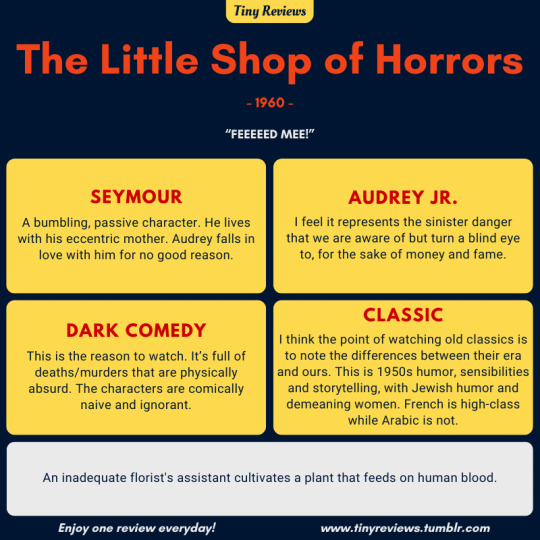
This is one of the oldest movies I have reviewed(second to Citizen Kane). Seeing young Jack Nicholson is a treat for me.
The story concept is by no means wholly original. Green Thoughts is a 1932 story by John Collier about a man-eating plant. The Flowering of the Strange Orchid is a 1894 short story by H.G. Wells. "The Reluctant Orchid" is a 1956 short story by Arthur C. Clarke.
The Little Shop of Horrors is a 1960 American horror comedy film directed by Roger Corman, written by Charles B. Griffith, starring Jonathan Haze, Jackie Joseph, Mel Welles, Dick Miller, and Myrtle Vail.
#the little shop of horrors#jonathan haze#jackie joseph#mel welles#dick miller#myrtle vail#dark comedy#horror comedy#seymour krelborn#audrey jr#1960
5 notes
·
View notes
Text
The Old Dark House; a twice told tale.
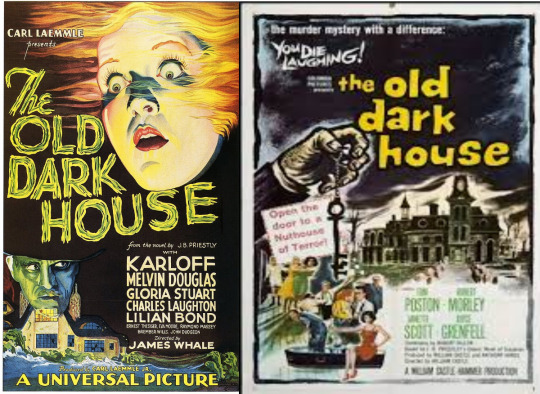
It was a dark and stormy night. Travelers find their car has developed problems and so they go to an old lonely house to seek shelter. In a stunning turn of events, nobody breaks into song, and there are no musical numbers. This isn’t after all, the Rocky Horror Picture Show, but “The Old Dark House” (1932), a pre-code Universal Horror film. In 1927, J.B Priestly (1894-1984)had a book published called “Benighted”. The book was a classic 'old dark house', which in films, had seen increasing popularity during the silent era, and has been referenced to this day in films like “The Rocky Horror Picture Show”, and Scooby Do cartoons. As popular as the old dark films were in the silent era, that popularity didn’t seem to carry into the sound era, and most of those made before WW2, were remakes of silent films, like “The Cat and the Canary”. One of these films that was not a remake was the 1932 “The Old Dark House”. Director James Whale saw some potential in the literary work “The Benighted”, and chose to make a film based on that book called “The Old Dark House”.
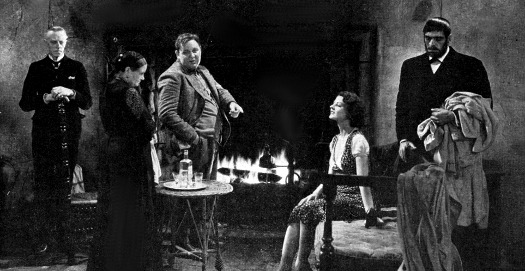
This was a film that Whale wanted to make, and he insisted Universal buy the film rights to the book. Whale selected the film's largely British cast, several of whose members were theater colleagues of his with minimal film experience, and would appear in several of his later films. These included Charles Laughton, Ernest Thesiger, and Boris Karloff. This may be the best performance from Thesiger, maybe even better then his performance as Dr. Pretorious in ‘Bride of Frankenstein”.

Although all nine of the New York daily papers gave the film positive reviews, many other publications gave it negative reviews. “Variety” calling it “Inane”. Initially, the film received good box office, but poor word of mouth saw box office receipts drop during the second week. The audience turn-out dropped to less than half in its second week and the film was pulled after ten days. In Britain the film did much better, even getting a re-release in 1939. Although not that popular in the United States, it did have a fan in Charles Addams. When his eccentric family made their very first appearance in 1938 in the New Yorker, The butler that would come to be known as Lurch, was clearly inspired by Karloff’s mad butler Morgan.

Universal would lose the rights to this movie in 1957, and it would be considered a lost film. A remake was released in 1963, directed by William Castle and co-produced with Hammer Films. Charles Addams would provide the title art for this movie, whose signature is painted by a hairy hand. That hairy hand (proto Thing?) and a very Charles Addams style Victorian house would be included in the poster art. Although the 1963 “The Old Dark House” is from the same source as the 1932 version, it is a very different film from the Whale film. This time, an American car salesman (Tom Poston) is asked to deliver a car by his roommate, to an old mansion on Dartmoor. In this case, In this version, a will requires that the members of a family descended form the pirate captain Morgan, are required to return to the dilapidated mansion before midnight each evening or forfeit his share of the family fortune. This story involves the different family members being bumped off one by one, while the Yank, bears witness to the strange proceedings.

The 1963 Old Dark House has developed a poor reputation, possibly in part, because of how it has been blamed for taking the place of the 1932 classic. William K Everson, author of “Classics of the Horror Film”, went so far as to call it a “practically blasphemous remake”. I get that. The 1932 film is a great classic film, and was nearly lost, but that wasn’t exactly the fault of the William Classic and Hammer remake. The fault is more that of Universal Studios, which allowed the film to become neglected. Director Curtis Harrington, a friend of James Whale, begged Universal to find the film, and it was located in 1968. It is easy to find now on DVD, or you can watch it for free on You Tube.
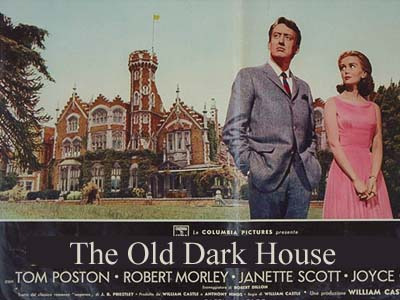
But is the 1963 film the “practically blasphemous remake” that Everson claimed? Of course not. Outside of the title, the two have almost nothing in common, and are different enough, you can watch one, without making comparison’s to the other. My first viewing of the 1963 film was on a 16 MM projector, being shown on a screen in my family’s back yard. I was very happy to see the Charles Addams opening, and I genuinely liked it, not being aware of the 1932 film, I was able to watch it without being troubled by the differences in the Hammer/Castle film, and the 1932 Whale classic. Catching it later on, I liked that the dilapidated mansion they used for the film was “Oakley Court”. If you have seen “The Rocky Horror Picture Show”, you would be familiar with the house. Being a Hammer co-production, it was in the vicinity of Hammer’s Bray studios, so it was used in a number of Hammer films.
I love both films enough to have them of DVD, and consider them both worth a watch.
#rocky horror picture show#Tom Poston#Charles Addams#Universal#Boris Karloff#Willaim Castle#James Whale#Hammer#the old dark house
6 notes
·
View notes
Note
Hello! Happy June! It's Pride and I have another question (4/30)
Today we are talking about queer representation in media. In 1894 "The Dickson Experimental Sound Film" is released, becoming the first "gay film". It was also known as "The Gay Brothers", it feature two men dancing together and it reportedly "shocked audiences with its subversion of conventional male behaviour". Unfortunately, in 1934 the USA introduced the Hays Code, which, while it didn't explicitly ban queerness, banned queerness in effect. This resulted in three decades of queer-coded villains, such as Joel Cairo in "The Maltese Falcon" (1941) and Jack Favell in "Rebecca" (1940).
The Hays Code was lifted in 1968, and the queer cult classic "The Rocky Horror Picture Show" was released in 1975, and gave a much-needed positive and FUN representation of queer people and queerness. Unfortunately, this was short-lived, as the rising AIDs crisis worsened the stigma around the gay community. This didn't stop everyone though, and in 1985 "Desert Hearts" was released; regarded as the first mainstream lesbian film with a happy ending.
Further on, the first gay kiss on TV in the UK was on "EastEnders" in 1989, "Ellen" became the first American tv show with an openly gay lead in 1997, and other show such as "Buffy the Vampire Slayer" started to add recurring LGBTQ+ characters. An important show in the UK was "Queer as Folk" (1999) which was one of the first shows to depict the queer community as vibrant and alive.
Even further forward, and "Moonlight" (2017) became the first LGBTQ+ film (and the first all-black cast) to win Best Picture at the Oscars. GLAAD publishes an annual report showing how representation is changing. 2005-2006 1.4% of regular characters vs 2020-2021 the figure is at 9.1%. So, there is still a long way to go obviously, especially because media is often the main or only place that young people have an insight into the community at all.
Because of this, I want to ask you for a recommendation: What is a piece of queer media that you think more people should see? (it can be literally anything, big/small, funny/sad, smart/stupid <- just anything you think deserves to be watched!:))
(I'll go first: "Eu Não Quero Voltar Sozinho" (or "I Don't Want to Go Back Alone) is a really really cute Brazillian short film available on Youtube! (if you enjoy it, there is also a full-length film version called "Hoje Eu Quero Voltar Sozinho" (or "The Way He Looks"))
Happy Pride 🌈 🎉
QUEER MEDIA ANYONE SHOULD SEE ITS EVILLIOUS CHRONICLES MORE SPECIGFICALLY THIS SONG PRODUCED BY MOTHY AND SUNG BY MIKU AND HAKU!! FIRST AND BEST GENDERQUEER LESBIAN STORY EVERRRRR
0 notes
Note
Hello! Happy June! It's Pride and I have another question (4/30)
Today we are talking about queer representation in media. In 1894 "The Dickson Experimental Sound Film" is released, becoming the first "gay film". It was also known as "The Gay Brothers", it feature two men dancing together and it reportedly "shocked audiences with its subversion of conventional male behaviour". Unfortunately, in 1934 the USA introduced the Hays Code, which, while it didn't explicitly ban queerness, banned queerness in effect. This resulted in three decades of queer-coded villains, such as Joel Cairo in "The Maltese Falcon" (1941) and Jack Favell in "Rebecca" (1940).
The Hays Code was lifted in 1968, and the queer cult classic "The Rocky Horror Picture Show" was released in 1975, and gave a much-needed positive and FUN representation of queer people and queerness. Unfortunately, this was short-lived, as the rising AIDs crisis worsened the stigma around the gay community. This didn't stop everyone though, and in 1985 "Desert Hearts" was released; regarded as the first mainstream lesbian film with a happy ending.
Further on, the first gay kiss on TV in the UK was on "EastEnders" in 1989, "Ellen" became the first American tv show with an openly gay lead in 1997, and other show such as "Buffy the Vampire Slayer" started to add recurring LGBTQ+ characters. An important show in the UK was "Queer as Folk" (1999) which was one of the first shows to depict the queer community as vibrant and alive.
Even further forward, and "Moonlight" (2017) became the first LGBTQ+ film (and the first all-black cast) to win Best Picture at the Oscars. GLAAD publishes an annual report showing how representation is changing. 2005-2006 1.4% of regular characters vs 2020-2021 the figure is at 9.1%. So, there is still a long way to go obviously, especially because media is often the main or only place that young people have an insight into the community at all.
Because of this, I want to ask you for a recommendation: What is a piece of queer media that you think more people should see? (it can be literally anything, big/small, funny/sad, smart/stupid <- just anything you think deserves to be watched!:))
(I'll go first: "Eu Não Quero Voltar Sozinho" (or "I Don't Want to Go Back Alone) is a really really cute Brazillian short film available on Youtube! (if you enjoy it, there is also a full-length film version called "Hoje Eu Quero Voltar Sozinho" (or "The Way He Looks"))
Happy Pride 🌈 🎉
Hi!! There is this Bollywood movie called "Chandigarh kare ashiqui" which has main character as trans. Idk how accurate the rep is but it was a big movie. Bollywood has been making lot of queer stories with good rep and i love that
0 notes
Note
Hello! Happy June! It's Pride and I have another question (4/30)
Today we are talking about queer representation in media. In 1894 "The Dickson Experimental Sound Film" is released, becoming the first "gay film". It was also known as "The Gay Brothers", it feature two men dancing together and it reportedly "shocked audiences with its subversion of conventional male behaviour". Unfortunately, in 1934 the USA introduced the Hays Code, which, while it didn't explicitly ban queerness, banned queerness in effect. This resulted in three decades of queer-coded villains, such as Joel Cairo in "The Maltese Falcon" (1941) and Jack Favell in "Rebecca" (1940).
The Hays Code was lifted in 1968, and the queer cult classic "The Rocky Horror Picture Show" was released in 1975, and gave a much-needed positive and FUN representation of queer people and queerness. Unfortunately, this was short-lived, as the rising AIDs crisis worsened the stigma around the gay community. This didn't stop everyone though, and in 1985 "Desert Hearts" was released; regarded as the first mainstream lesbian film with a happy ending.
Further on, the first gay kiss on TV in the UK was on "EastEnders" in 1989, "Ellen" became the first American tv show with an openly gay lead in 1997, and other show such as "Buffy the Vampire Slayer" started to add recurring LGBTQ+ characters. An important show in the UK was "Queer as Folk" (1999) which was one of the first shows to depict the queer community as vibrant and alive.
Even further forward, and "Moonlight" (2017) became the first LGBTQ+ film (and the first all-black cast) to win Best Picture at the Oscars. GLAAD publishes an annual report showing how representation is changing. 2005-2006 1.4% of regular characters vs 2020-2021 the figure is at 9.1%. So, there is still a long way to go obviously, especially because media is often the main or only place that young people have an insight into the community at all.
Because of this, I want to ask you for a recommendation: What is a piece of queer media that you think more people should see? (it can be literally anything, big/small, funny/sad, smart/stupid <- just anything you think deserves to be watched!:))
(I'll go first: "Eu Não Quero Voltar Sozinho" (or "I Don't Want to Go Back Alone) is a really really cute Brazillian short film available on Youtube! (if you enjoy it, there is also a full-length film version called "Hoje Eu Quero Voltar Sozinho" (or "The Way He Looks"))
Happy Pride 🌈 🎉
oh there are so many things i could pick, so i'm going to do one i think a lot of people haven't seen which is alex strangelove. it's a netflix original movie from like 2018, its a coming of age story about a teen boy coming to terms with his sexuality but it also is one of the funniest things i've ever watched. there's one specific scene i literally laughed so hard i couldn't breathe the first time i watched it. also its the movie that introduced me to the band muna who are one of my favorite bands of all time
0 notes
Note
Hello! Happy June! It's Pride and I have another question (4/30)
Today we are talking about queer representation in media. In 1894 "The Dickson Experimental Sound Film" is released, becoming the first "gay film". It was also known as "The Gay Brothers", it feature two men dancing together and it reportedly "shocked audiences with its subversion of conventional male behaviour". Unfortunately, in 1934 the USA introduced the Hays Code, which, while it didn't explicitly ban queerness, banned queerness in effect. This resulted in three decades of queer-coded villains, such as Joel Cairo in "The Maltese Falcon" (1941) and Jack Favell in "Rebecca" (1940).
The Hays Code was lifted in 1968, and the queer cult classic "The Rocky Horror Picture Show" was released in 1975, and gave a much-needed positive and FUN representation of queer people and queerness. Unfortunately, this was short-lived, as the rising AIDs crisis worsened the stigma around the gay community. This didn't stop everyone though, and in 1985 "Desert Hearts" was released; regarded as the first mainstream lesbian film with a happy ending.
Further on, the first gay kiss on TV in the UK was on "EastEnders" in 1989, "Ellen" became the first American tv show with an openly gay lead in 1997, and other show such as "Buffy the Vampire Slayer" started to add recurring LGBTQ+ characters. An important show in the UK was "Queer as Folk" (1999) which was one of the first shows to depict the queer community as vibrant and alive.
Even further forward, and "Moonlight" (2017) became the first LGBTQ+ film (and the first all-black cast) to win Best Picture at the Oscars. GLAAD publishes an annual report showing how representation is changing. 2005-2006 1.4% of regular characters vs 2020-2021 the figure is at 9.1%. So, there is still a long way to go obviously, especially because media is often the main or only place that young people have an insight into the community at all.
Because of this, I want to ask you for a recommendation: What is a piece of queer media that you think more people should see? (it can be literally anything, big/small, funny/sad, smart/stupid <- just anything you think deserves to be watched!:))
(I'll go first: "Eu Não Quero Voltar Sozinho" (or "I Don't Want to Go Back Alone) is a really really cute Brazillian short film available on Youtube! (if you enjoy it, there is also a full-length film version called "Hoje Eu Quero Voltar Sozinho" (or "The Way He Looks"))
Happy Pride 🌈 🎉
Ohhhh sorry this is going to be very basic and silly cuz it's all I can think of off the top of my head, but The Owl House is written by a queer creator for queer people! The main character is bi and she gets together with a canon lesbian, and it includes the first canon non-binary disney character who uses they/them pronouns! It's full of diverse representation and it extra great because it's something I desperately wish I had as a kid, but am so happy that other kids get to grow up with it :]
Besides the queer representation, it's a fun story with a lot of creepy elements, though the end is a little rough because it was suddenly cancelled so season three was only three hour long specials
1 note
·
View note
Text
The forbidden game movie

The forbidden game movie movie#
The forbidden game movie series#
Your name is Alex, a newly hired janitor at the Hotel Dolphin, making your first night at his new night job, with the main objective of cleaning and organizing all the rooms for future guests, however. This begins an epic journey from Phoenix’s humble. When the hero of the game, Phoenix, seeks the counsel of a druid to make sense of his visions, she awakens the latent pyromancy within him.
The forbidden game movie series#
The master of the game, Julian, is none other than the salesman of the store where the so-called game was found.Īlthough the release date of the series is not yet known, the title search already allows for some brainstorming. An indie horror game that tells the story of a supposedly cursed room in a hotel called the Dolphin Hotel. Summary: The Forbidden Arts is an action adventure platformer with a focus on discovery and exploration. SMITH, Lisa Jane Smith, is the New York Times 1 Bestselling author of The Vampire Diaries, The Secret Circle, The Forbidden Game, Dark Visions.
The forbidden game movie movie#
The group then finds themselves in different parallel worlds where they have to face their worst nightmares or risk having their souls imprisoned forever. Released January 2nd, 1995, Forbidden Games stars Jeff Griggs, Lesli Kay, Gail Harris, Amy Weber The R movie has a runtime of about 1 hr 29 min, and received a user score of 50 (out of 100) on. Originally released as a horror story for teenagers, “The Forbidden Game” tells the life of Jenny and her six friends as they play a game similar to Jumanji during the birthday of her boyfriend, Tom. Sarah Schechter, David Madden and Greg Berlanti will be the executive producers. The rights of this trilogy, of which the first volume was published in 1994, were acquired a few days ago by Warner Bros Television and Berlanti Productions. Smith fans will be delighted: after the “The Vampire Diaries” saga, it is now the turn of another series by the writer to be adapted for the small screen: “The Forbidden Game”. While perhaps not the innovator that fellow R… Bruce Beresford, Nationality: Australian. Enter into the Forbidden World - an outrageous, sexy, and violent exercise. His many film credits i… Film Noir, The genre known as film noir emerged from economic, political, and moral crises in European and American cultures in the years leading up to World Wa… Andrei Arsenievich Tarkovsky, Russian film director Andrei Tarkovsky (1932-1986) was, arguably, the greatest filmmaker of his nation. In the distant future, a federal marshal arrives at a research lab on a remote planet where a monstrous genetic experiment is loose and feeding on the scientists who created it. Career: Journalist in Copen… Alain Resnais, French film director Alain Resnais (born 1922) was one of the most noted innovators in the history of twentieth-century film. Hello Moi cest Mhyre, je réalise principalement des Game Movies et des lets play sur les nouvelles sorties jeux.TECHNIQUES MONTAGE Gameplay maitrisé Tr. Family: Married Ebba Larsen, 1911, two sons. Jean Renoir, French-born Jean Renoir (1894-1979) directed two of the twentieth century's most critically acclaimed films, La Grande Illusion and La Regle du jeu (… Carl Theodor Dreyer, DREYER, Carl Theodor

0 notes
Text
bertie when she was in the kitchen eating her snacks and everyone started screaming outside because they were being chased by jingles and rr
#ahs: 1984#ahs 1984#bertie#american horror story 1894#this is also her when xavier comes bursting through the kitchen door#xavier plympton
212 notes
·
View notes
Text

so i just saw this post and listen.... i get that zach villa (the guy who plays richard ramirez) is hot... BUT PLS FOR THE LOVE OF FUCKING CHRIST HIMSELF DO NOT CALL THAT MAN YOUR BABE. HES NOT A FICTIONAL CHARACTER. HE IS ONE OF THE WORST SERIAL KILLERS/RAPISTS OFF ALL TIME. S T O P.
#ahs#ahs 1984#american horror story 1894#american horror story#richard rameriz#hes fucked up#like insanely fucked up#please stop oml#this is some true crime fucker bullshit#its disgusting
63 notes
·
View notes
Text
Soo...is American Horror Story: 1894 camp or just bad?
#ahs: 1984#billie lourd#angelica ross#matthew morrison#cody fern#john lynch#john caroll lynch#leslie grossman#gus kenworthy#american horror story#ahs#emma roberts#ryan murphy#evan peters#jessica lange#taissa farmiga#sarah paulson#american horror story 1894#ahs 1984#ahsfx#fxx#horror#horror movie#camp
5 notes
·
View notes
Text
2021 Reading Log, pt 32

156. PNSO Encyclopedia for Children: The Secrets of Ancient Sea Monsters by Zhao Chuang and Yang Yang. This is probably the least of the three PNSO Secrets of books. The text comes off as awfully judgmental about the swimming capabilities of a number of the marine reptiles covered within, and the inconsistencies in the art are noticeable (a Tylosaurus depicted with clawed flippers on one page, without on another, that sort of thing). A number of the anecdotes in the book were already inaccurate when it was written in 2015 (Elasmosaurus with swan-like necks attacking fish from above, plesiosaurs in general beaching themselves to lay eggs). I do commend the coverage, however. About five placodontids appear in the book, as well as several choristoderes and pistosaurs. And most books aimed at this age set view marine reptiles as a sideshow for the dinosaurs, instead of devoting an entire volume to them.
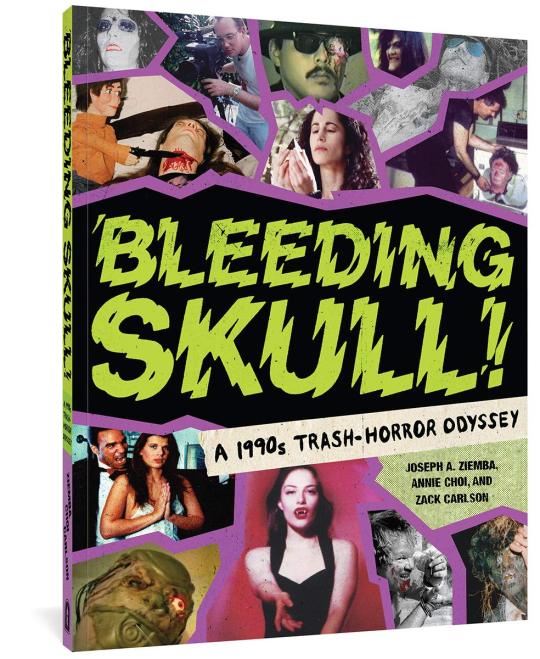
157. Bleeding Skull! A 1990s Trash Horror Odyssey by Joseph A. Ziemba, Annie Choi and Zack Carlson. This book is a collection of reviews about direct-to-video horror movies of the 1990s, almost all of them independently produced and shot on video. There’s a genuine affection for the movies involved—Ziemba is the director of the American Genre Film Archive, and you don’t have that kind of position if you don’t love schlock. It’s basically the book I wanted Analog Nightmares from last year to be: it’s not uncritical of the Z-grade movies on display, but instead can tell the difference between a good viewing experience and a bad one. And I may have developed a parasocial crush on Annie Choi based on her writings found here.

(note: this is not the cover of the edition I read, but that’s a library-bound copy that’s more than a century old. Unsurprisingly, no images of that exact version exist online, and it’s a pretty boring cover besides)
158. Curious Myths of the Middle Ages by Sabine Baring-Gould. The oldest book I’ve read this year, published originally in 1866, in an American edition from 1894. Baring-Gould was a pioneer of folklore studies, and is writing primarily about European myths—Prester John, Pope Joan, William Tell and the like. Baring-Gould has a passion for the idea of the Ur-Myth later espoused by authors like James Frazer in The Golden Bough, and like in that book is a little too eager to assume that the Indian version of all of these Indo-European stories is the “original”. He’s also definitely blinded by his role as an Anglican minister. He accuses basically everyone except Catholics and Anglicans of being idolaters and heretics (in later chapters he is especially huffy about Methodists secretly being holdovers of Druidism), is wildly antisemetic at times, and occasionally views stories as corrupted versions of the Biblical truth. A valuable resource for people interested in European myth and folklore, but not one to be taken uncritically.

159. Around the World in 80 Plants by Jonathan Drori, illustrated by Lucille Clerc. This book is as much about the social history of plants as it is about their biology. The countries the plants are attributed to are ones where the plant has cultural importance rather than necessarily being its origin. For example, castor beans are discussed in Italy in the context of Fascist torture methods, and opium poppies are covered under Australia because Tasmania is a major global supplier. The tone is droll, slightly moralizing, and very British. The illustrations, which to my untrained eye appear to be in pastels and colored pencil, are lovely. The book is worth checking out on their merit alone.
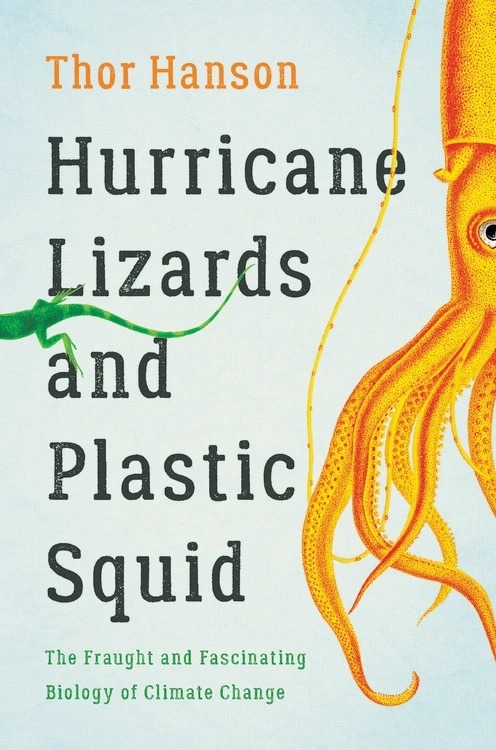
160. Hurricane Lizards and Plastic Squid by Thor Hanson. The subject of the book is how the behavior and evolution of life is changing in response to climate change. Range shifts, behavioral and phenotypic plasticity, and evolutionary adaptations are all covered here. The tone is conversational, and the topics covered flow well together. I like the focus on individual scientists, their research, and the recurring theme of all of these specialists pivoting to climate change studies as the 20th century ended and the 21st century began. What I didn’t like was how the last chapter doubled down on personal responsibility being the primary way to solve the climate crisis. The average person supports green policies! It’s the fossil fuel companies and their inroads into government that are preventing it from happening! Turning off the lights when we leave the room isn’t going to fucking cut it, Thor!
#reading log#medieval folklore#b-movies#climate change#evolution#ecology#botany#marine reptiles#children's books#paleontology#gore tw#sorta
44 notes
·
View notes
Text
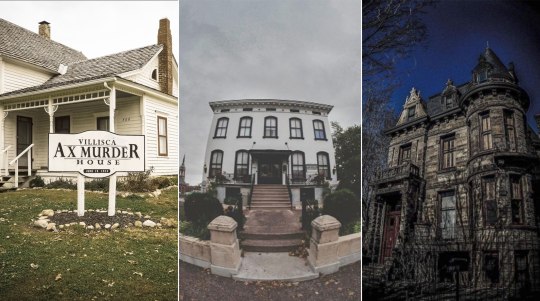
9 Terrifying American Murder Houses
From Amityville Horror to Jeffrey Dahmer’s one-bedroom, these murder houses are home to some truly brutal murders.
Forget the haunted house put on by your high school. The walls of these real-life murder houses witnessed some of the most brutal killings in American history. Several of the homicides remain unsolved, and some residents claim restless spirits still haunt the grounds. So step on in, if you dare…
9. THE AMITYVILLE HORROR HOUSE
112 OCEAN AVE, AMITYVILLE, NY
Note to first-time home buyers: when the deal is too good, start asking questions. In 1975, George and Kathy Lutz bought this sprawling Dutch Colonial on the south shore of Long Island at a bargain rate. The reason for the discounted price tag? Just 13 months earlier, previous resident Ronald “Butch” DeFeo slaughtered his parents and four younger siblings while they slept in their beds. It didn’t take long for the weirdness to begin – demonic voices, oozing walls, cloven hoof prints in the snow. The Lutz family lasted just two months before fleeing 112 Ocean Avenue in the night.
8. THE HEX MURDER HOUSE
REHMEYERS HOLLOW RD, SHREWSBURY, PA
In 1928, John Blymire was convinced a reclusive neighbor named Nelson Rehmeyer had put a hex upon him. Believing the only way to break the curse was to track down Rehmeyer’s spell book and set it ablaze, Blymire rallied two buddies for a late-night visit. While the gang never found the book, they did find Rehmeyer – whom they murdered and mutilated before setting his body on fire. In 2007, an effort was made to open the Hex House to the public, but the plan was eventually scrapped.
7. MOORE FAMILY AXE MURDER HOUSE
508 E 2ND ST, VILLISCA, IA
On a cool summer night in 1912 someone broke into this peaceful Iowa homestead and bludgeoned all six family members plus two houseguests with an axe. The horrific scene was discovered the following morning by a concerned neighbor. Numerous suspects were named in the case – including a traveling minister and State Senator Frank F. Jones. Nevertheless, the murder remains unsolved.
6. KREISCHER MANSION
4500 ARTHUR KILL RD, STATEN ISLAND, NY
German entrepreneur Balthasar Kreischer built this sprawling mansion in 1885 as a symbol of his success in the brick making business. Alas, the good times were short-lived. By 1894, his company had crumbled and his youngest son had shot himself in the head. The decaying mansion sat empty for years until its groundskeeper used the property for a mob hit in 2005. Joseph Young strangled and stabbed his target before finally drowning the man in a garden pool. Young then hacked up the body and burned it in the mansion’s incinerator.
5. LIZZIE BORDEN HOUSE
230 2ND ST, FALL RIVER, MA
On August 4, 1892 Andrew Borden was thrashed with a hatchet while he dozed on the couch of his parlor. Andrew’s second wife Abby met an equally grisly end in the upstairs bedroom. While everyone in Fall River suspected daughter Lizzie of the crime, the local judge remained unconvinced. She was tried and acquitted of the murder one year later. Oddly, the home is now a successful bed & breakfast.
4. MANSON FAMILY MURDER HOUSE
10050 CIELO DRIVE, LOS ANGELES, CA
In 1969, members of the Manson Family shocked the nation when they broke into this L.A. estate and slaughtered Sharon Tate along with four other victims. The murderers wrote “pig” in blood across the front door. Numerous residents have since called 10050 Cielo Drive home – including musician Trent Reznor, who recorded THE DOWNWARD SPIRAL there. In 1994, the original structure was razed and replaced with a new mansion, currently occupied by the creator of FULL HOUSE.
3. JEFFREY DAHMER’S APARTMENT
924 NORTH 25TH ST, APT 213, MILWAUKEE, WI
Cannibal killer Jeffrey Dahmer lured numerous victims to his nondescript one-bedroom, where he drugged and dismembered them in a brutal campaign of murder. Severed limbs were packed in the freezer for future consumption; torsos were dumped in a vat of acid. Police finally arrested Dahmer in 1991 after one of his prisoners managed to escape. The entire apartment building was torn down shortly thereafter.
2. JOHN WAYNE GACY’S HOUSE
8213 SUMMERDALE AVE, CHICAGO, IL
It’s always good to know your neighbors – especially if you suspect them of murder. John Wayne Gacy buried dozens of bodies in the basement and backyard of his suburban home while neighbors casually went about their day. When Gacy’s wife complained of a putrid smell, Gacy blamed it on dead mice. By the time police nabbed the infamous killer clown and excavated his 8213 Summerdale Ave property, they uncovered 29 bodies.
1. GARDETTE-LAPRETE HOUSE
1240 BURGUNDY ST, NEW ORLEANS, LA
How’s this for a Mardi Gras story? In the late 1830s, plantation owner Jean LePrete leased his French Quarter Greek Revival to a mysterious man from Turkey. The renter, known only as “The Sultan,” had more than a few roommates; he arrived with a massive entourage of eunuchs and concubines. The house quickly became known for its lavish parties, with music and revelry carrying on into the night. One morning, a passerby noticed 1240 Burgundy was eerily quiet. Then he spotted blood seeping out of the door. When authorities entered, they found everyone inside had been murdered and dismembered. As for The Sultan? He was buried alive in the courtyard. To this day, the case remains unsolved.
#9 Terrifying American Murder Houses#haunted locations#paranormal#ghost and hauntings#ghost and spirits#haunted salem#myhauntedsalem
53 notes
·
View notes
Text


Originally published in 1932, Burn Witch, Burn is a prequel to Creep Shadow, Creep. Reprinted in Famous Fantastic Mysteries, the novel was accompanied by Virgil Finlay. It was filmed in 1936 by Tod Browning as the movie The Devil-Doll starring Lionel Barrymore.
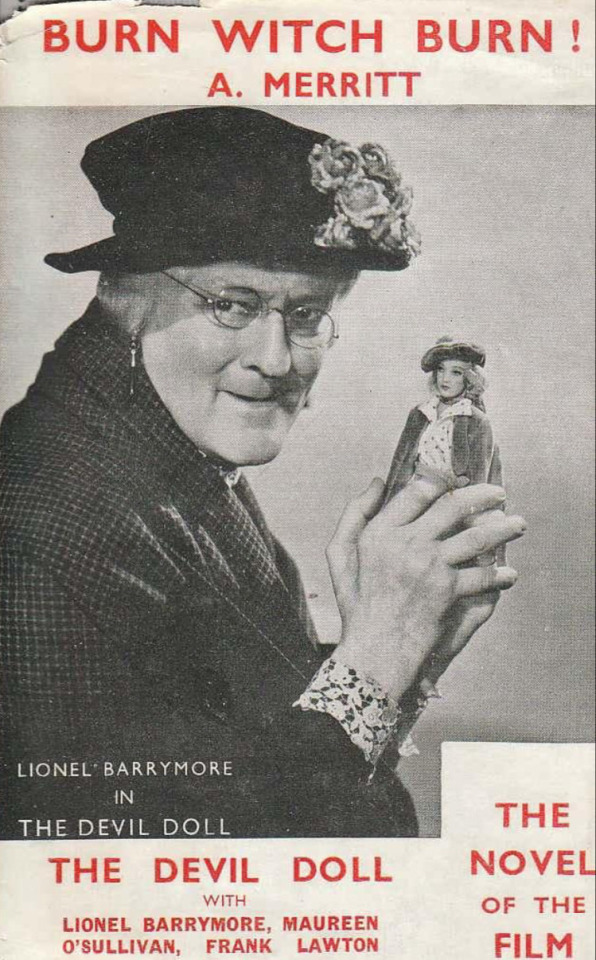


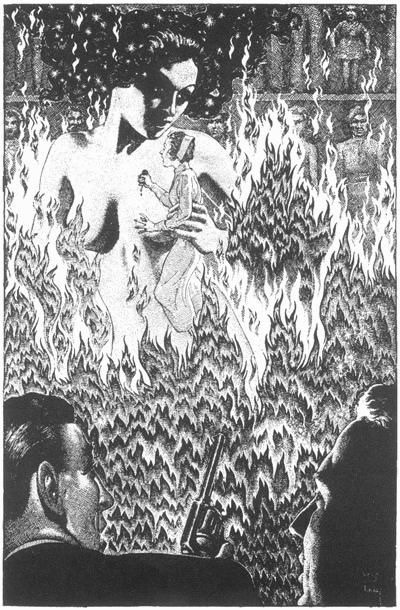


‘Abraham Grace Merritt, wrote under the name of A. Merritt, born in New Jersey moved as a child to Philadelphia, Pa. in 1894, began studying law and than switched to journalism. Later a very popular writer starting in 1919 of the teens, twenties and thirties, horror and fantasy genres. King of the purple prose, most famous The Moon Pool, a south seas lost island civilization, hidden underground and The Ship of Ishtar, an Arabian Nights type fable, and six other novels and short stories collections (he had written at first, just for fun). Nobody could do that variety better, sold millions of books in his career. The bright man, became editor of the most successful magazine during the Depression, The American Weekly , with a fabulous $100,000 in salary. A great traveler, in search of unusual items he collected. His private library of 5,000 volumes had many of the occult macabre kind. Yet this talented author is now largely been forgotten.’ — Goodreads

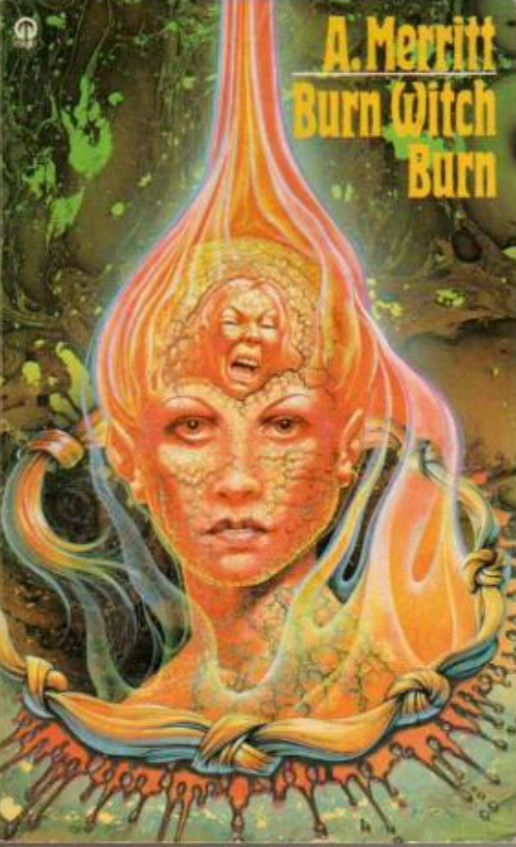
#book blog#books#book cover#books books books#horror#mystery thriller#pulp#pulp art#pulp fantasy#virgil finlay
2 notes
·
View notes